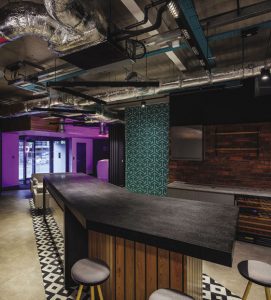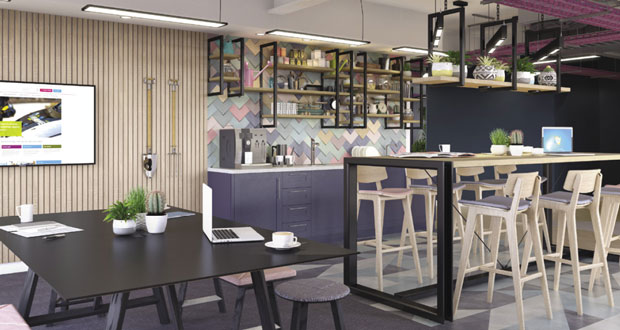 Ann Clarke, Director of The Future Workplace at nationwide workplace consultancy and interior design business Claremont, suggests the Hub and Spoke office could be the future of the workplace
Ann Clarke, Director of The Future Workplace at nationwide workplace consultancy and interior design business Claremont, suggests the Hub and Spoke office could be the future of the workplace
Just over a year ago – the world wondered if the office was dead and permanent homeworking would be the pandemic’s legacy. Now, with 12 months of remote working under our collective belts and a clear desire among employees to return to the workplace for some of the working week – we have turned our attentions to how the office must respond.
The hub and spoke office model is one concept gaining traction as it offers greater flexibility and reflects a new set of behaviours – but what does it really mean for businesses and their FM teams? And how does it impact ergonomics?
Hub and spoke describes the idea of having one primary central or head office, typically in a city centre – with smaller satellite offices or flexible spaces in secondary locations which are closer to where employees live.
Intended to offer the best of both worlds it means that employees don’t have to commute to a city centre space and instead can access smaller localised workspaces for the collaboration and community that homeworking doesn’t offer. With fewer people commuting every day, large expensive head offices can be reimagined as dynamic brands hubs – all while occupying smaller footprints and realising cost savings.
The pandemic is the biggest driver of this model and it serves to highlight the changing dynamics of how and where work is done. In turn, it presents a compelling opportunity for employers to look at the role of the workplace with fresh eyes – a process that starts with understanding how our relationship with the office has been changing for some time.
Even before lockdown there was a significant downturn in peak desk occupation and an increase overall in empty desks – just 46 per cent of desks were occupied in 2019/20. Interestingly average use of meeting rooms was only 35 per cent and collaboration spaces recorded a similarly dismal occupancy of 16 per cent overall. Despite the drive for purposeful co-worker collaboration of recent years, the settings provided by many organisations have not been supporting staff optimally. They have been missing the mark.
 So if workplaces weren’t supporting how work was done before the pandemic – they most definitely will not when our new-found desire for hybrid working plays out. It’s against this backdrop that workplace reinvention and the hub and spoke model in particular has real appeal – but in doing so, there are six primary ergonomic considerations to address:
So if workplaces weren’t supporting how work was done before the pandemic – they most definitely will not when our new-found desire for hybrid working plays out. It’s against this backdrop that workplace reinvention and the hub and spoke model in particular has real appeal – but in doing so, there are six primary ergonomic considerations to address:
Needs and motivations
Organisations must understand what their people need to thrive and what this requires of property and environment.
Workplace and employee needs analysis can help to identify the right geographic locations, buildings and workplace amenities for both the hub and the spokes. After a prolonged period away from the workplace this is particularly useful as remote working has changed processes, behaviours and what we’ll need when we do come together.
For example – even when there’s a meeting in the office, it’s likely there will always be some remote participants. This means large board rooms have much less relevance. Instead, smaller meeting pods improve the experience for physical attendees, and integrated tech and collaboration tools make it easy for remote attendees to participate fully and have parity of experience. This will need to take into account mixed presence collaboration, lighting, reducing strobing patterns, daylight control, proximity to screen and screen size, acoustics, voice capture and amplification.
At a more strategic level, businesses need to reflect on these needs and be clear about the role and purpose of both hub and spoke spaces. Are the spoke offices for meetings, head-down working or both? And what will be at the hub (facilities or experiences) that would make people want to go there?
Experiences
 The universal acceptance that many jobs can be carried out at home requires the office to take on a new role and offer what remote working cannot – namely positive experiences rich in employers’ brand values, collaboration, community and learning.
The universal acceptance that many jobs can be carried out at home requires the office to take on a new role and offer what remote working cannot – namely positive experiences rich in employers’ brand values, collaboration, community and learning.
From an ergonomic point of view this means boardroom spaces and desk-covered floors have less relevance, as our data shows, in favour of more variety and bookable work spaces, tech-enabled collaboration hubs, learning lounges and on site cafes. It also requires an understanding of demand for these spaces and the sort of tasks that will be undertaken.
Perhaps the hub’s role is as a ‘university’ – so it becomes a beacon for knowledge and learning experiences, or it is ‘project HQ’ where the focus is on collaborative tasks and team experiences.
The ability to shape positive experiences will, in part, be borne out of the needs and motivations analysis and will require the input of the senior management team – as this is more than an opportunity to redesign the workplace, but to revisit organisational ethos and convey employer brand values.





